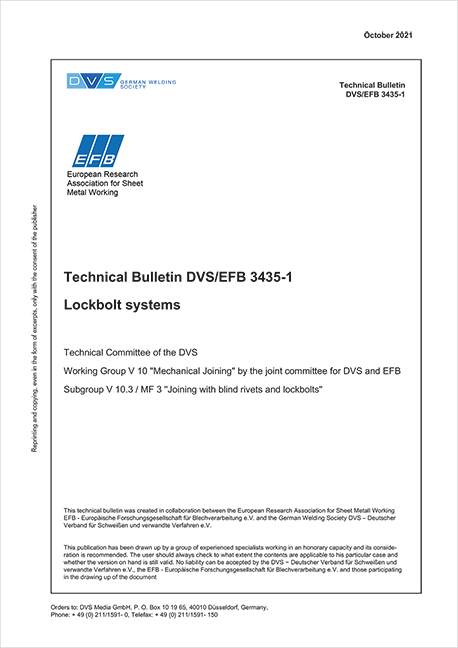Lockbolt Systems
Medien-Nr.:
MB-3435-1e
Produktnummer:
MB_3435-1e
Herausgeber:
Europäische Forschungsgesellschaft Blechverarbeitung e.V. und DVS – Deutscher Verband für Schweißen und verwandte Verfahren e.V. - Gemeinschaftsausschuss "Mechanisches Fügen"
Erscheinungsjahr:
1. Oktober 2021
Seitenanzahl:
39
The Technical Bulletin “Lockbolt systems” has been drafted by a group of experienced specialists
during a voluntary joint project and is recommended as an important source of knowledge that needs
to be observed. The data published in the Technical Bulletin has been gathered and compiled from
numerous publicly funded research and industrial projects and from internal investigations.
Its dedicated purposes are:
• To generally inform the users of lockbolt systems about the function of lockbolt technology,
• To determine the mechanical and physical properties,
• To introduce testing methods for characterising and measuring these mechanical and physical properties,
• To inform about the assembly processes,
• To assure quality.
Content
1. Purpose and scope of the Technical Bulletin
2. Basic principles
2.1. Terms
2.1.1. Lockbolt systems
2.1.2. Lockbolt
2.1.3. Collar
2.1.4. Joint
2.1.5. Connection
2.1.6. Preload
2.2. Designs
2.3. Strength grades
2.4. Materials
2.5. Surface protection
2.6. Assembly processn
2.7. Installation Toolingn
2.8. Locking effect with transverse loading conditionsn
3. Testing lockbolt systemsn
3.1. Essential testingn
3.1.1. Hardness testn
3.1.2. Shear forcen
3.1.3. Tensile forcen
3.2. Further test methods for special applicationsn
3.2.1. Specification of dimensionsn
3.2.2. Tensile strength of lockbolt materialn
3.2.3. Impact strengthn
3.2.4. Assembly preloadn
3.2.5. Fatigue strengthn
4. Quality assurance
4.1. Warranties for lockbolts/collar quality.
4.2. Quality assurance of lockbolt connections
4.2.1. Non-destructive quality control
4.2.2. Destructive quality control
5. Tables
6. Literature
Its dedicated purposes are:
• To generally inform the users of lockbolt systems about the function of lockbolt technology,
• To determine the mechanical and physical properties,
• To introduce testing methods for characterising and measuring these mechanical and physical properties,
• To inform about the assembly processes,
• To assure quality.
The dimensioning and structural design of joints with lockbolts can be conducted in accordance with Technical Bulletin DVS/EFB 3435-2 [1]. It lies in the user’s responsibility to check the extent to which
the information presented in this Technical Bulletin is up-to-date and is applicable to their particular
case.
Content
1. Purpose and scope of the Technical Bulletin
2. Basic principles
2.1. Terms
2.1.1. Lockbolt systems
2.1.2. Lockbolt
2.1.3. Collar
2.1.4. Joint
2.1.5. Connection
2.1.6. Preload
2.2. Designs
2.3. Strength grades
2.4. Materials
2.5. Surface protection
2.6. Assembly processn
2.7. Installation Toolingn
2.8. Locking effect with transverse loading conditionsn
3. Testing lockbolt systemsn
3.1. Essential testingn
3.1.1. Hardness testn
3.1.2. Shear forcen
3.1.3. Tensile forcen
3.2. Further test methods for special applicationsn
3.2.1. Specification of dimensionsn
3.2.2. Tensile strength of lockbolt materialn
3.2.3. Impact strengthn
3.2.4. Assembly preloadn
3.2.5. Fatigue strengthn
4. Quality assurance
4.1. Warranties for lockbolts/collar quality.
4.2. Quality assurance of lockbolt connections
4.2.1. Non-destructive quality control
4.2.2. Destructive quality control
5. Tables
6. Literature

